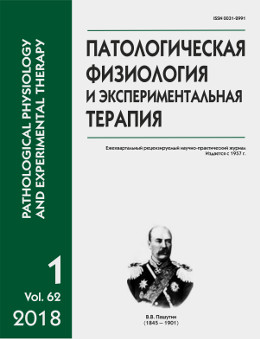Assessment of the influence of physical activity by a modified method on metabolic processes in students
Abstract
Introduction of new methods of athletic training and physical education requires obligatory medical support. The optimal approach is the technique that allows achieving intensive progress of sports mastery and physical fitness under conditions of greatest balance of individual indicators and integrated level of functional systems that determine the adaptive reserves of the body and fully meet the criteria of healthy population of the same age and gender. Informative diagnostics of functional adequacy of physical exercise can be achieved via simultaneous multivariate testing of systems determining the integral body homeostasis. Goal. Evaluation of changes in prevailing direction of metabolic processes during physical exercise by the original methodology characterized by intensive physical exercise. Methods. Urine samples from 179 first-second-year students aged 17.5±1.5 years (initially), 126 girls and 53 boys, were analyzed by laser correlation spectroscopy. To study parameters of psychomotor regulation (UPMD-01-INTOKS complex) and their correlations with predominant direction of metabolic processes 600 schoolchildren of both sexes aged 15-16 years without documented chronic diseases (I health group) were tested. Results. Baseline parameters were measured to characterize the prevailing directions of metabolic shifts in the examined group before the start of training by the developed technique. Predominant contribution of catabolic and anabolic shifts (49% and 41%, respectively) and minor contribution of mixed (7%) and normal (3%) shifts were found. After 1-year training by the developed technique, the number of students with anabolic type of metabolic processes significantly decreased. As anabolic shifts decrease and catabolic shifts increase, the frequencies of the longest movement cycles of both extensors and flexors, the most erroneous corrections, and the most stressed states of flexor-extensor muscles decreased. This pattern was revealed for all 5 independent criteria and in strict accordance with the increase of catabolic and decrease in anabolic shifts. Conclusion. The revealed correlation between the directions of metabolic processes and some psychomotor parameters suggests that this technique will have a positive impact on the health of students.
Downloads
References
2. Akmaev I.G., Aleksandrov A.S., Alchinova I.B., Bocharov E.V., Karganov M.Yu., Kryzhanovskii G.N. et al. Sanology [Sanologiya]. Мoscow: Nauka; 2014. (in Russian)
3. Anishchenko A.P., Arkhangelskaya A.N., Dmitrieva E.A., Urakov A.L., Rogoznaya E.V., Ignatov N.G. et al. Development and justification of modified technique of physical training for students. Vestnik novykh meditsinskikh tekhnologiy. 2016; 23(6): 105-9. (in Russian)
4. Anishchenko A.P., Arhangelskaya A.N., Gurevich K.G., Dmitrieva E.A., Ignatov N.G., Osadchenko I.V. et al. Improvement of physical education programmes for students. Medical aspects. Sportivnaya meditsina: nauka i praktika. 2016; 6(2): 73-81. (in Russian)
5. Titov V.N., Karganov M.Yu., Rotenko A.A., Dmitriyev V.A., Alchinova I.B., Arkhipova E.N. Biological functions and biological reactions. Laser correlation spectroscopy in the evaluation of intercellular medium purity. Klinicheskaya laboratornaya diagnostika. 2009; (6): 21-35. (in Russian)
6. Karganov M.Yu., Alchinova I.B., Yakovenko E.N., Kovaleva O.I., Medvedeva Yu.S., Vyalkina M.V. Application of the method of laser correlation spectroscopy in laboratory medicine. Klinicheskaja laboratornaja diagnostika. 2016; 61(9): 533-4. DOI 10.18821 / 0869-2084-2016-61-9. (in Russian)
7. Pankova N.B., Lebedeva M.A., Slezko V.N., Khorkin N.N., Vinogradov V.N., Kurneshova L.E. et al. Psycho-motor co-ordination and sensory-motor reactivity in patients with vertebral pathology. Patogenez. 2003; 1(1): 86-9. (in Russian)
8. Aleshchenko A.V., Alchinova I.B., Dmitrieva O.S., Dmitrieva G.P., Karganov M.Yu., Kozhevnikova M.I. et al. Use of a cytogenetic method for buccal epithelium study, and a method of laser correlation spectrometry for health disturbances monitoring in children. Tsitologiya. 2006; 48(2): 169-72. (in Russian)
9. Pankova N.B., Alchinova I.B., Afanasieva E.V., Karganov M.Yu. Characteristics of cardiovascular system indexes and nature of metabolic changes in adolescents with pre-hypertention from different regions of Russia. Valeologiya. 2009; (2): 32-6. (in Russian)
10. Karganov M., Alchinova I., Arkhipova E., Dubovoi R. Non-invasive polysystemic analysis of ecological and anthropogenic factors influence on children. J. Trends of Biomedicine. 2009; 24(1): 26-7.
11. Anishchenko A.P., Arhangelskaya A.N., Ignatov N.G., Gurevich K.G. Physical training and sport for weight management in children and teenagers. Sportivnaya meditsina. 2016; (3): 85-91. (in Russian)
12. Anishchenko A.P., Arkhangelskaya A.N., Ignatov N.G., Gurevich K.G. Dynamics of medical school undergraduate students’ physical development and physical readiness indicators under the influence of physical training with the primary use of ashtanga-yoga. Fizicheskaya kul'tura i sport: nauka i praktika. 2016; (4): 61-6. (in Russian)






